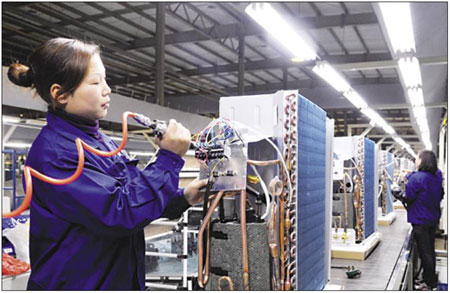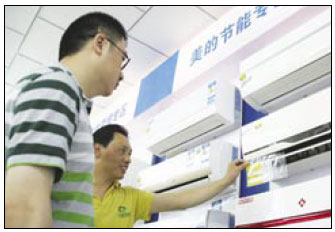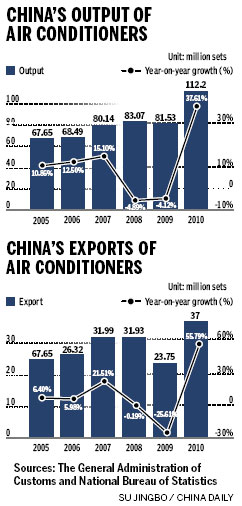China-US
Air conditioner makers bouncing back
Updated: 2011-05-25 11:01
By Zhong Nan (China Daily)
|
The air conditioning market in China is experiencing some gains after a couple of steady years. In 2010, 112 million units were manufactured, compared with 81.5 million a year before. Provided to China Daily |
|
Chinese air conditioner makers need to improve after-sales services to appeal to foreign consumers, experts say. Xu Ruiping / for China Daily |
|
|
BEIJING - It is the busiest season for Gree Electric Appliances, China's largest maker of air conditioners. The temperature has reached 32 C in Zhuhai, the southern coastal city where Gree is headquartered. In Gree's 800,000-square-meter factory complex, workers in navy blue uniforms brave the summer heat to pack approximately 2,000 air conditioners in a storage bungalow, while 10 trucks are lined up to take the air conditioners to a port 10 kilometers away.
But these air conditioners are not going to be sold in China. Instead, they will arrive in Hamburg, Germany, in 25 days, one of several examples that the global demand for Chinese air conditioners is rebounding.
China, which makes the highest total number of air conditioners of any nation, saw its air conditioner industry suffer during the recent recession. Exports of air conditioners dropped 25.6 percent year-on-year to 23.75 million units in 2009.
But since the government approved a home appliance subsidy program in 2009, rural spending on air conditioners has grown. Chinese air conditioner makers are also facing an easier time, industry experts claim, and global demand for the appliances rallied last year.
"Chinese enterprises to a certain extent took advantage of (the recession) by speeding up research and development and overseas expansion," said Li Jinlin, dean of the School of Management and Economics at Beijing Institute of Technology.
What Chinese air conditioner makers did wasn't rocket science. They first expanded their marketing reach across the nation and then improved after-sales services, emphasized their respective brands and grew their research and development departments in order to expand overseas.
Last year, China produced a total of 112 million air conditioners. Exports grew by 55.8 percent from a year earlier to 36.99 million units. China's three largest air conditioner brands - Haier, Gree and Midea - accounted for 87 percent of China's total air conditioner exports last year, according to the China Household Electrical Appliances Association.
Su Ming, director of marketing for air conditioners at Haier, said: "The global credit crunch showed us that labor-intensive and original equipment manufacturer enterprises don't have much chance to survive during the recession because they don't have any technological advantages and they thought the market demand would be there forever. In contrast, we rely on research and development to expand the European Union (EU) market and our air conditioning products also gained the qualification of using the ETL-EU mark."
The mark is a safety certification distinction used across the EU.
"Haier has 28 research and development centers around the world but the EU has always been our focus because it has strong purchasing power. We have air conditioner innovation centers in Lyon, France; and Amsterdam, the Netherlands, and we employ European designers to enhance our competitive power," Su said.
The Qingdao-based company has 10 factories in Europe, the United States, Asia, the Middle East and Africa. It sells air conditioners in more than 110 countries and regions.
Last year, sales of Haier air conditioners increased by 31.2 percent to 11.4 billion yuan ($1.75 billion) from 2009. Ten percent of Haier's air conditioners were exported to the EU last year. The United Kingdom, Germany, France, Spain, Italy and Greece are the company's main targets in the EU.
Dong Mingzhu, president of Gree, said providing high-quality, after-sales services has helped her company stay on solid footing in foreign markets. Dong said air conditioner companies can use after-sales services to network with consumers and offer them more information about their brands.
"The EU and the US consumers usually have a higher expectation on after-sales services. No matter how good your products are, they won't choose your brand if you cannot provide them high-quality, after-sales service such as replacing parts or repairing the refrigeration system."
Gree has established a global sales and after-sales network in more than 190 countries and regions, with more than 1,100 stores selling air conditioners and more than 2,000 foreign employees.
Dong said there is no one-stop solution in the air-conditioning business, adding that companies have to learn how people spend in different foreign markets.
Gree operates eight factories - five in China and in Brazil, Pakistan and Vietnam - with overseas plants contributing to 20 percent of its volume. It chalked up profits of about 4.6 billion yuan on sales of 60.8 billion yuan in 2010. Sales increased 42.6 percent year-on-year.
"Thanks to a large domestic industrial chain, the Chinese air conditioning industry has already achieved a major breakthrough in developing variable-frequency and green air conditioners. Offering high-quality after-sales service could significantly improve the marketing credibility of Chinese brands on the international stage," said Feng Yanhui, a professor of mechanical engineering at Beijing University of Science and Technology.
In 2009, major Chinese enterprises stopped exporting fixed-frequency air conditioners to meet new energy efficiency standards from various foreign governments, according to the China Refrigeration and Air-Conditioning Industry Association.
But there is also some stiff competition across the globe for Chinese air conditioner makers. Japan's Toshiba and Mitsubishi, South Korea's LG and Samsung are striking hard to enter the Southeast Asian market. Sweden's Electrolux and US-based Whirlpool are two other major air conditioner sellers in the Australian market.
Su Bojiang, deputy secretary-general of the China Refrigeration and Air-Conditioning Industry Association, said Chinese enterprises are investing more in technologies.
Su said foreign air conditioning companies are aware that their Chinese competitors have been heavily promoting their brands in new markets.
Guangdong Midea Electric Appliances Co Ltd, which sold 48 billion yuan worth of air conditioners last year, is reportedly planning to heavily expand overseas this year.
A Midea employee, who asked for anonymity, said the demand for high-end air conditioners will remain high in EU and US markets. But "we will make more efforts to sell our products in Russia, India, Brazil and Southeast Asia this year. The branding campaign will be our key tactic in developing new markets", said the employee, who added that the company is working with major retailers in foreign countries and attempting to establish joint venture companies.
Both Haier and Midea say the appreciation of the yuan as well as the increasing costs of labor, materials, chemical refrigerants, energy and transportation are affecting profit margins in China's air conditioner industry.
The China Household Electrical Appliances Association predicts the cost to export air conditioners will increase from 5 percent to 8 percent this year because of rises in costs.
Experts caution Chinese companies from emphasizing prices in competing with rivals and instead say they should stress technology and services.
Li, at the Beijing Institute of Technology, said Chinese air conditioner makers are keen on winning over foreign consumers by using their latest technologies, putting out appealing advertisements and improving after-sales service in foreign markets.
China Daily
Specials

Suzhou: Heaven on Earth
Time-tested adages sing praises of Suzhou, and Michael Paul Franklin finds it's not hard to understand why on a recent visit.

The sky's the limit
Chinese airline companies are increasingly recruiting pilots and flight attendants as the industry experiences rapid expansion.

Diving into history
China's richest cultural heritage may lie in the deep, like exhibits in a giant underwater museum.


